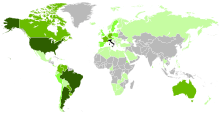
Italian diaspora
Italian people and their descendants living outside Italy / From Wikipedia, the free encyclopedia
Dear Wikiwand AI, let's keep it short by simply answering these key questions:
Can you list the top facts and stats about Italian diaspora?
Summarize this article for a 10 year old
The Italian diaspora (Italian: emigrazione italiana, pronounced [emiɡratˈtsjoːne itaˈljaːna]) is the large-scale emigration of Italians from Italy. There were two major Italian diasporas in Italian history. The first diaspora began around 1880, two decades after the Unification of Italy, and ended in the 1920s to the early 1940s with the rise of Fascist Italy.[3] Poverty was the main reason for emigration, specifically the lack of land as mezzadria sharecropping flourished in Italy, especially in the South, and property became subdivided over generations. Especially in Southern Italy, conditions were harsh.[3] From the 1860s to the 1950s, Italy was still a largely rural society with many small towns and cities having almost no modern industry and in which land management practices, especially in the South and the Northeast, did not easily convince farmers to stay on the land and to work the soil.[4]
 Map of the Italian diaspora in the world | |
| Total population | |
| c. 80 million worldwide[1] | |
| Regions with significant populations | |
| Brazil, Argentina, United States, France, Colombia, Canada, Peru, Uruguay, Australia, Venezuela, Germany, Switzerland, United Kingdom, Belgium, Chile and Paraguay | |
| Languages | |
| Italian, other languages of Italy, English, French, Spanish, Portuguese and German | |
| Religion | |
| Christianity (predominantly Catholicism)[2] | |
| Related ethnic groups | |
| European diaspora, Italians |
Another factor was related to the overpopulation of Italy as a result of the improvements in socioeconomic conditions after Unification.[5] That created a demographic boom and forced the new generations to emigrate en masse in the late 19th century and the early 20th century, mostly to the Americas.[6] The new migration of capital created millions of unskilled jobs around the world and was responsible for the simultaneous mass migration of Italians searching for "bread and work" (Italian: pane e lavoro, pronounced [ˈpaːne e llaˈvoːro]).[7]
The second diaspora started after the end of World War II and concluded roughly in the 1970s. Between 1880 and 1980, about 15,000,000 Italians left the country permanently.[8] By 1980, it was estimated that about 25,000,000 Italians were residing outside Italy.[9] Between 1861 and 1985, 29,036,000 Italians emigrated to other countries; of whom 16,000,000 (55%) arrived before the outbreak of World War I. About 10,275,000 returned to Italy (35%), and 18,761,000 permanently settled abroad (65%).[10]
A third wave, primarily affecting young people, widely called "fuga di cervelli" (brain drain) in the Italian media, is thought to be occurring, due to the socioeconomic problems caused by the financial crisis of the early 21st century. According to the Public Register of Italian Residents Abroad (AIRE), the number of Italians abroad rose from 3,106,251 in 2006 to 4,636,647 in 2015 and so grew by 49% in just 10 years.[11] There are over 5 million Italian citizens living outside Italy,[12] and c. 80 million people around the world claim full or partial Italian ancestry.[1]
Internal migration within the Italian geographical borders also occurred for similar reasons;[13] its largest wave consisted of 4 million people moving from Southern Italy to Northern Italy (and mostly to Northern or Central Italian industrial cities like Rome or Milan, etc.), between the 1950s and 1970s.[14] Today there is the National Museum of Italian Emigration (Italian: Museo Nazionale dell'Emigrazione Italiana, "MEI"), located in Genoa, Italy.[15] The exhibition space, which is spread over three floors and 16 thematic areas, describes the phenomenon of Italian emigration from before the unification of Italy to present.[15] The museum describes the Italian emigration through autobiographies, diaries, letters, photographs and newspaper articles of the time that dealt with the theme of Italian emigration.[15]